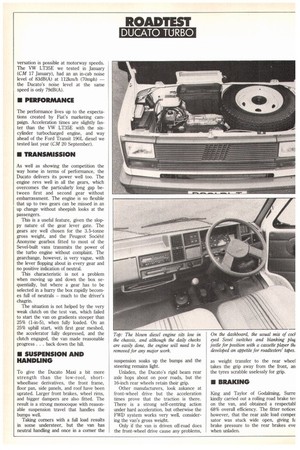• SUSPENSION AND HANDLING
Page 50

If you've noticed an error in this article please click here to report it so we can fix it.
To give the Ducato Maxi a bit more strength than the low-roof, shortwheelbase derivatives, the front frame, floor pan, side panels, and roof have been uprated. Larger front brakes, wheel rims, and bigger dampers are also fitted. The result is a strong monocoque with reasonable suspension travel that handles the bumps well.
Taking corners with a full load results in some understeer, but the van has neutral handling and once in a corner the suspension soaks up the bumps and the steering remains light.
Unladen, the Ducato's rigid beam rear axle hops about on poor roads, but the 16-inch rear wheels retain their grip.
Other manufacturers, look askance at front-wheel drive but the acceleration times prove that the traction is there. There is a strong self-centring action under hard acceleration, but otherwise the FWD system works very well, considering the van's gross weight.
Only if the van is driven off-road does the front-wheel drive cause any problems, as weight transfer to the rear wheel takes the grip away from the front, an the tyres scrabble uselessly for grip.










































































